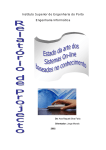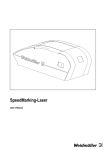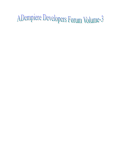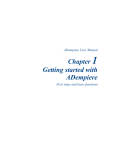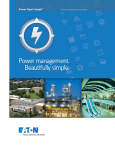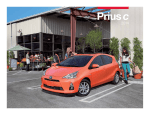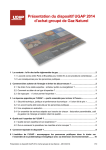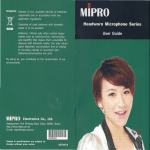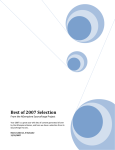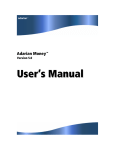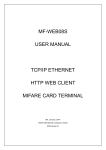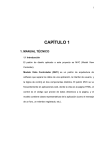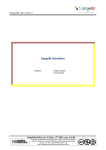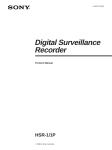Download Part A ADempiere Overview
Transcript
ADempiere User Manual Part A ADempiere Overview Copyright This document is Copyright © 2008 by its contributors as listed in the section titled Authors. You can distribute it and/or modify it under the terms of either the GNU General Public License, version 2 or later (http://www.gnu.org/licenses/gpl.html), or the Creative Commons Attribution License, version 3.0 (http://creativecommons.org/licenses/by/3.0/) or later. All trademarks within this guide belong to their legitimate owners. Authors Bepi Esposito Vingiano Heinz-Günter Siebert (Oscar) Pelgrim Feedback Maintainer of Part A: Heinz-Günter Siebert (oscar) Please direct any comments or suggestions about this document to: [email protected] Publication date and software version First time published June 2nd, 2008. Based on Adempiere 350a - Revision 01: June 4th, 2008. Adempiere 3.5.1a – Rev. 5331 Table of Content Introduction..........................................................................................................................................6 1.1 ERP History..............................................................................................................................6 1.1.1 Material Resource Planning – MRP..................................................................................6 1.1.2 Manufacturing Resource Planning I – MRP I...................................................................6 1.1.3 Manufacturing Resource Planning II – MRP II................................................................7 1.1.4 Enterprise Resource Planning – ERP................................................................................7 1.1.5 Advanced Production Schedule – APS.............................................................................7 1.2 Free Software............................................................................................................................7 1.3 Open Source..............................................................................................................................8 2 Architecture and Concepts................................................................................................................9 2.1 Schema's explaining the application (data) structure................................................................9 2.1.1 Client......................................................................................................................................9 2.1.2 User........................................................................................................................................9 2.1.3 Role......................................................................................................................................10 2.1.4 Business Partner Group.......................................................................................................10 2.1.5 Customer..............................................................................................................................11 2.1.6 Vendor..................................................................................................................................11 2.1.7 Employee.............................................................................................................................11 2.1.8 Price list...............................................................................................................................12 2.1.9 Discount Schema.................................................................................................................12 2.1.10 Dunning.............................................................................................................................12 2.1.11 Payment terms....................................................................................................................13 2.1.12 Warehouse..........................................................................................................................13 2.1.13 Product definition..............................................................................................................13 2.1.14 Attribute Set.......................................................................................................................14 2.1.15 Attribute Set Instance.........................................................................................................14 2.1.16 Product Inventory..............................................................................................................15 2.1.17 Product Price / Communication.........................................................................................15 2.1.18 Workflow...........................................................................................................................16 2.1.19 Calendar.............................................................................................................................16 2.1.20 Tax......................................................................................................................................17 2.1.21 Requisition.........................................................................................................................17 2.1.22 Requisition.........................................................................................................................17 2.2 Used terms..............................................................................................................................19 2.2.1 Client....................................................................................................................................19 2.2.2 Users....................................................................................................................................19 2.2.3 Role......................................................................................................................................19 2.2.4 Organization.........................................................................................................................19 2.2.5 Organization type.................................................................................................................19 2.2.6 Business Partner...................................................................................................................19 2.2.7 Business Partner Group.......................................................................................................19 2.2.8 Business Relation.................................................................................................................19 2.2.9 Customer..............................................................................................................................19 2.2.10 Vendor................................................................................................................................19 2.2.11 Employee...........................................................................................................................20 2.2.12 Supervisor..........................................................................................................................20 2.2.13 Substitute...........................................................................................................................20 2.2.14 Position..............................................................................................................................20 2.2.15 Organization Assignment...................................................................................................20 2.2.16 Organization Access..........................................................................................................20 2.2.17 Pricelist..............................................................................................................................20 2.2.18 Dunning.............................................................................................................................20 2.2.19 Discount Schema...............................................................................................................20 2.2.20 Purchase Pricelist...............................................................................................................20 2.2.21 PO Discount Schema.........................................................................................................20 2.2.22 Pricelistversion...................................................................................................................20 2.2.23 Pricelistschema..................................................................................................................21 2.2.24 Pricelistschemaline............................................................................................................21 2.2.25 Productprice.......................................................................................................................21 2.2.26 Product...............................................................................................................................21 2.2.27 Productcategory.................................................................................................................21 2.2.28 Discount type.....................................................................................................................21 2.2.29 Discount break...................................................................................................................21 2.2.30 Level..................................................................................................................................21 2.2.31 Payment terms....................................................................................................................21 2.2.32 Schedule.............................................................................................................................21 2.2.33 Warehouse..........................................................................................................................21 2.2.34 Source Warehouse..............................................................................................................21 2.2.35 Replenish...........................................................................................................................22 2.2.36 Replenish type....................................................................................................................22 2.2.37 Locator...............................................................................................................................22 2.2.38 Storage...............................................................................................................................22 2.2.39 Attribute Set Instance.........................................................................................................22 2.2.40 Related...............................................................................................................................22 2.2.41 BOM..................................................................................................................................22 2.2.42 Related Producttype...........................................................................................................22 2.2.43 UOM..................................................................................................................................22 2.2.44 Conversion.........................................................................................................................22 2.2.45 Product Category...............................................................................................................22 2.2.46 Producttype........................................................................................................................22 2.2.47 Attribute Set.......................................................................................................................23 2.2.48 Attribute Set Instance.........................................................................................................23 2.2.49 Attribute Use......................................................................................................................23 2.2.50 Attribute.............................................................................................................................23 2.2.51 Attribute Value...................................................................................................................23 2.2.52 Attribute Value Type..........................................................................................................23 2.2.53 Attribute Search.................................................................................................................23 2.2.54 Exclude table......................................................................................................................23 2.2.55 Shipment, Receipts............................................................................................................23 2.2.56 Movement..........................................................................................................................23 2.2.57 Invoice...............................................................................................................................23 2.2.58 Freight Category................................................................................................................23 2.2.59 Replenish type....................................................................................................................23 2.2.60 Purchasing..........................................................................................................................24 2.2.61 Mail Template....................................................................................................................24 2.2.62 User Mail...........................................................................................................................24 2.2.63 Download...........................................................................................................................24 2.2.64 Price...................................................................................................................................24 2.2.65 Tax Category......................................................................................................................24 2.2.66 Transactions.......................................................................................................................24 2.2.67 Revenue Recognition.........................................................................................................24 2.2.68 Revenue Recognition Plan.................................................................................................24 2.2.69 Revenue Recognition Run.................................................................................................24 2.2.70 Workflow...........................................................................................................................24 2.2.71 Access................................................................................................................................24 2.2.72 Workflow type...................................................................................................................25 2.2.73 Node...................................................................................................................................25 2.2.74 Process Parameter..............................................................................................................25 2.2.75 Parameter...........................................................................................................................25 2.2.76 Transition...........................................................................................................................25 2.2.77 Condition...........................................................................................................................25 2.2.78 Table Column.....................................................................................................................25 2.2.79 Action.................................................................................................................................25 2.2.80 Calendar.............................................................................................................................25 2.2.81 Year....................................................................................................................................25 2.2.82 Non Business Day..............................................................................................................25 2.2.83 Period.................................................................................................................................26 2.2.84 Period Control....................................................................................................................26 2.2.85 Tax Category......................................................................................................................26 2.2.86 Charge................................................................................................................................26 2.2.87 Tax Rate.............................................................................................................................26 2.2.88 Parent Tax..........................................................................................................................26 2.2.89 Tax ZIP...............................................................................................................................26 2.2.90 Requisition.........................................................................................................................26 2.2.91 Requisition line..................................................................................................................26 2.2.92 Document type...................................................................................................................26 2.2.93 Purchase Order...................................................................................................................26 2.2.94 GL Category.......................................................................................................................26 2.2.95 Category type.....................................................................................................................27 2.2.96 Document Basetype...........................................................................................................27 2.2.97 Document Sequence..........................................................................................................27 2.2.98 Print Format.......................................................................................................................27 2.2.99 Display Order.....................................................................................................................27 2.2.100 Sort Order........................................................................................................................27 2.2.101 Format Item......................................................................................................................27 2.3 AD...........................................................................................................................................28 2.4 Architecture.............................................................................................................................29 2.5 Project structure......................................................................................................................30 3Adempiere ERP-Business Suite.......................................................................................................32 3.1 Key Features...........................................................................................................................32 3.1.1 Complete ERP.................................................................................................................32 3.1.2 Supply Chain Management - SCM.................................................................................33 3.1.3 Customer Relationship Mangement - CRM....................................................................34 3.1.4 Performance Analysis.....................................................................................................34 3.2 A strategic tool that will evolve with your company..............................................................34 3.3 Current Developments............................................................................................................35 3.3.1 Manufacturing Management...........................................................................................35 3.3.2 Global Tax Management.................................................................................................35 3.3.3 Human Resource & Payroll ...........................................................................................35 4 Installation......................................................................................................................................36 Introduction With ERP-systems, there is a new aera of „Free Software“, which goes beyond the functionality of more technical oriented „Free Software“ like compilers, the GNU/Linux operating system or application server like Jboss. The ADempiere ERP Business Suite (called Adempiere in the later) does provide the basis for SME and does offer an alternative to SAP, Oracle or Navision. One of the many definitions of ERP: „A software architecture that facilitates the flow of information between all functions within a company such as manufacturing, logistics, finance and human resources.“1 and one definition of an ERP-System is: „ An ERP-system is an informationsystem, that implements business processes and rules for all main business departments inside an enterprise as well as between enterprises.“2 „Traditional IT systems are mostly built around an accounting package with different software to cater to the seemingly unrelated departments' needs. But how often do these different underlying systems lead to isolated pockets of data within the organisation? The answer, unfortunately, is too often. Information is usually held in the large amount of data that the organizations already have, such as data ranging from supply chain level to customer facing departments (e.g. sales data, stock information, customer data, market information, etc.). Within this explosion of data lie the answers that management needs to define its strategy and manage the business properly. Some examples of issues encountered in the traditional IT systems are as follows: ● Only a compartmental view of the activities of the business are available. Too much time is spent piecing the varying departmental information together rather than using the information itself. ● Information gaps exist (due to the lack of communication between some departments) and are only filled by derived information or expensive and inefficient bridges. ● Duplicates of data are formed, which need comparing and cross-checking. Management spends valuable time locating the errors and inconsistent data. ● Difficulty scaling with a growing company. As the company grows, the old IT system is replaced with a different system and inherits the same flaws. Naturally, all this results in many inefficiencies, loss of revenue as well as higher cost of management that could be eliminated through an implementation of ADempiere.“3 1.1 ERP History 1.1.1 Material Resource Planning – MRP The original MRP-Concept has been developed in the 50th / 60th . This concept is used at plant level. This was possible, because the capacity of computers has increased to handle the magnitude of data to be processed. Times have changed from consumption-oriented to demandoriented requirements planning. 1.1.2 Manufacturing Resource Planning I – MRP I In the 70th in addition to MRP the planning of production programs was included as an enhancement and called MRP I. The planning methods does include magnitude as well as time planning, 1 Blanchard 2 Kurbel, P. 241 (Mauth) 3 http://www.adempiere.com/wiki/images/3/34/Why_should_a_company_implement_ADempiere_v2.pdf Chapter 1. Copyright Posterita, licence GPL but both were strictly separated. They were part of the so-called successive planning method. 1.1.3 Manufacturing Resource Planning II – MRP II With MRP II strategic information have been added to the planning process. Strategic information are sales and development forecast information to calculate the required Material and plan the required times to fullfil a customer's order, which is the base for the primary demand. After having determiend the primary demand, the next planning step is to determine the necessity to order additional material which is not on stock, but required for the primary demand. If all demands are determined the next step will be initiated. This step consists of the time planning to determine the production time and the required resources. All these information will be the base for initiating the production process in order to deliver the ordered product just in time with no or minimal waste of resources and costs. 1.1.4 Enterprise Resource Planning – ERP With the introduction of ERP, the production focus was extended to consider customer and market-orientation to be used in the complete planning and production process from procurement to sales with respect to consider all enterprise resources. 1.1.5 Advanced Production Schedule – APS All improvements, which have been made from MRP to ERP have made a lot of progress. With the globalization process and just in time production, it is getting more and more important to consider inter-enterprise communication for suplly chain management. It is important to udnerstand, that SCM is not a 1:1 relationship, but in the worst case a n:m relationship, which have to taken into account for so-called ERP-Systems. The service-orientation is only one aspect to interconnect loosly-coupled enterprise systems. Interface have to be provided, which does allow, to take vendor stock information into account, when setting up own production schedules. Hiwever, this kind of communication will required trust between business partners. This has to be learned. It has to be learned to replace intra-enterprise trust with inter-enterprise trust. This is a business issue. 1.2 Free Software The Free Software project was initiated by Richard M. Stallman in 1984 and was called the GNU (GNU's not Unix) project. The idea behind Free Software is a freely available unix like operating system as a basis for exchanging information and knowledge. This idea was born, when computer manufacturers did not support anymore open but proprietary software. Proprietary software delimits the exchange of information and impeded faster results in research work, as Stallman was accustomed to at the MIT. Free Software is based on the so called four freedoms4: ● The freedom to run the program, for any purpose (freedom 0). ● The freedom to study how the program works, and adapt it to your needs (freedom 1). Access to the source code is a precondition for this. ● The freedom to redistribute copies so you can help your neighbor (freedom 2). ● The freedom to improve the program, and release your improvements to the public, so that the whole community benefits (freedom 3). Access to the source code is a precondition for this. For example GNU/Linux and the ADempiere ERP Business Suite are Free Software based on GNU/GPL Version 2. 4 http://www.gnu.org/philosophy/free-sw.html 1.3 Open Source The term Open Source was created in 1998 by the Open Source Initiative (OSI) and can be seen as a marketing programm for „Free Software“. „The OSI is actively involved in Open Source community-building and education. OSI Board members frequently travel the world to attend Open Source conferences and events, meet with open source developers and users, and to discuss with executives from the public and private sectors about how Open Source technologies, licenses, and models of development can provide economic and strategic advantages.“5 5 http://www.opensource.org/about 2 Architecture and Concepts 2.1 Schema's explaining the application (data) structure 2.1.1 Client 2.1.2 User 2.1.3 Role 2.1.4 Business Partner Group 2.1.5 Customer 2.1.6 Vendor 2.1.7 Employee 2.1.8 Price list 2.1.9 Discount Schema 2.1.10 Dunning 2.1.11 Payment terms 2.1.12 Warehouse 2.1.13 Product definition 2.1.14 Attribute Set 2.1.15 Attribute Set Instance 2.1.16 Product Inventory 2.1.17 Product Price / Communication 2.1.18 Workflow 2.1.19 Calendar 2.1.20 Tax 2.1.21 Requisition 2.1.22 Requisition 2.2 Used terms 2.2.1 Client The Client is the highest level of an independent business entity. Each Client will have one or more Organizations reporting to it. Each Client defines the accounting parameters (Accounting Schema, Tree definition, Non Monetary UOM's) In most cases client will be the name of the company using ADempiere. 2.2.2 Users Users can log into the system and have access to functionality via one or more roles. A user can also be a business partner contact 2.2.3 Role The User Roles Tab define the Roles each user may have. The Roles will determine what windows, tasks, processes and workflows that a User has access to. 2.2.4 Organization An Organization is often a legal entity or sub-unit for which documents and transactions are processed. Normally physical locations like office, company branche, shops, factory location, ... 2.2.5 Organization type Organization Type allows you to categorize your organizations for reporting purposes 2.2.6 Business Partner The Business Partner is any party with whom you transact. This includes customers, vendors and employees. (have Back Account, Location, Contact, Withholdiing) 2.2.7 Business Partner Group The Business Partner Group window allows you to define the accounting parameters at a group level. If you define the accounting parameters for a group any Business Partner entered using this group will have these accounting parameters automatically populated. You can then make any modifications necessary at the Business Partner level. 2.2.8 Business Relation Business Partner Relation allow to maintain Third Party Relationship rules: who receives invoices for shipments or pays for invoices. 2.2.9 Customer Business partner is customer 2.2.10 Vendor Business partner is vendor 2.2.11 Employee Business partner is employee 2.2.12 Supervisor Supervisor for this user/organization - used for escalation and approval 2.2.13 Substitute A user who can act for this user 2.2.14 Position Job position 2.2.15 Organization Assignment Assign Users to Organizations 2.2.16 Organization Access Client and organizations the user has access to. Entries here are ignored, if in the Role, User Org Access is not selected or the role has access to all roles 2.2.17 Pricelist Price lists determine currency and tax treatment. Price list versions allow to maintain parallel lists for different date ranges. The most current pricelist version is used based on the document date. All pricelists have three prices: List, Standard and Limit 2.2.18 Dunning Dunning is the process of methodically communicating with customers to insure the collection of accounts receivable 2.2.19 Discount Schema Trade discount schema calculates the trade discount percentage 2.2.20 Purchase Pricelist Pricelist used for purchase in own organisations 2.2.21 PO Discount Schema Discount Schema for Purchase Order 2.2.22 Pricelistversion Price lists are automatically created based on Product Purchasing Information and the Vendor Category Discount 2.2.23 Pricelistschema Price List schema defines calculation rules for price lists 2.2.24 Pricelistschemaline Trade Discount Price List Lines Pricelists are created based on Product Purchase and Category Discounts. The parameters listed allow to copy and calculate pricelists 2.2.25 Productprice prices for a product based on the selected price list 2.2.26 Product defines all products used by an organization. These products include those sold to customers, used in the manufacture of products sold to customers and products purchased by an organization 2.2.27 Productcategory allows you to define different groups of products. These groups can be used in generating Price Lists, defining margins and for easily assigning different accounting parameters for products 2.2.28 Discount type Type of procedure used to calculate the trade discount percentage 2.2.29 Discount break Trade discount based on breaks (steps) 2.2.30 Level timing and frequency of the dunning notices 2.2.31 Payment terms defines the different payment terms that you offer your customers and that are offered to you by your vendors. Each invoice must contain a Payment Term 2.2.32 Schedule Payment Schedule 2.2.33 Warehouse defines each Warehouse, any Locators for that Warehouse and the Accounting parameters to be used for inventory in that Warehouse 2.2.34 Source Warehouse Optional Warehouse to replenish from 2.2.35 Replenish defines the type of replenishment quantities. This is used for automated ordering. If you select a custom replenishment type, you need to create a class implementing org.compiere.util.ReplenishInterface and set that on warehouse level 2.2.36 Replenish type Method for reordering a product 2.2.37 Locator defines any Locators (physical places) 2.2.38 Storage Detail Storage Information 2.2.39 Attribute Set Instance Set of attributes values 2.2.40 Related Related Product - e.g. for promotions 2.2.41 BOM defines those products that are generated from other products. A Bill of Material (BOM) is one or more Products or BOMs 2.2.42 Related Producttype Product type of Related product 2.2.43 UOM Unit of Measure, defines a unique non monetary Unit of Measure 2.2.44 Conversion defines the rates for converting a Unit of Measure. The system provides some automatic conversions between units of measures 2.2.45 Product Category allows you to define different groups of products. These groups can be used in generating Price Lists, defining margins and for easily assigning different accounting parameters for products 2.2.46 Producttype type of product also determines accounting consequences 2.2.47 Attribute Set define Product Attribute Sets to add additional attributes and values to the product. You need to define a Attribute Set if you want to enable Serial and Lot Number tracking 2.2.48 Attribute Set Instance Attribute values for Attribute Set 2.2.49 Attribute Use Attributes Used for the Product Attribute Set 2.2.50 Attribute Product Attribute like Color, Size, etc. If it is an Instance Attribute, all products have the same value 2.2.51 Attribute Value Individual value of a product attribute 2.2.52 Attribute Value Type The Attribute Value type deternines the data/validation type 2.2.53 Attribute Search Attributes are specific to a Product Attribute Set (e.g. Size for T-Shirts: S,M,L). If you have multiple attributes and want to search under a common attribute, you define a search attribute 2.2.54 Exclude table Create a record, if you want to exclude the ability to enter Product Attribute Set information 2.2.55 Shipment, Receipts Material Shipment and Receipt Lines 2.2.56 Movement Material Movement Lines 2.2.57 Invoice AP / AR Invoice Lines 2.2.58 Freight Category used to calculate the Freight for the Shipper selected 2.2.59 Replenish type indicates if this product will be manually re-ordered, ordered when the quantity is below the reminimum quantity or ordered when it is below the maximum quantity 2.2.60 Purchasing define the pricing and rules ( pack quantity, UPC, minimum order quantity) for each product 2.2.61 Mail Template Mail templates can contain variables of the user, business partner or a general object. The priority of parsing is User/Contact, Business Partner and then the underlying business object (like Request, Dunning, Workflow object) 2.2.62 User Mail Mail sent to the user 2.2.63 Download Define downloads for a product. If the product is an asset, the user can download the data 2.2.64 Price displays the List, Standard and Limit prices for each price list a product is contained in 2.2.65 Tax Category provides a method of grouping similar taxes. For example, Sales Tax or Value Added Tax 2.2.66 Transactions the transactions that have been processed for this product 2.2.67 Revenue Recognition defines the intervals at which revenue will be recognized. You can also base the revenue recognition on provided Service Levels 2.2.68 Revenue Recognition Plan is generated then invoicing a product with revenue recognition. With Revenue Recognition, the amount is posted to the Unrecognized revenue and over time or based on Service Level booked to Earned Revenue 2.2.69 Revenue Recognition Run Revenue Recognition Run History 2.2.70 Workflow defines Workflows in the system, the access level for the Workflow and the Nodes or Steps within the Workflow 2.2.71 Access defines the Roles who have access to this Workflow 2.2.72 Workflow type The type of workflow determines how the workflow is started 2.2.73 Node defines each Node, Activity or step in this Workflow 2.2.74 Process Parameter * Only Set Customization * Validate current (old) value 2.2.75 Parameter Parameter for the execution of the Workflow Node 2.2.76 Transition Next Nodes Tab defines the order or Nodes or Steps in a Workflow 2.2.77 Condition Optional restriction of transition of one node to the next 2.2.78 Table Column Link to the database column of the table 2.2.79 Action Actions can be: * Apps Report (Process) * Document Action (Document Action) * Email (Email Recipient, Email Template) * Set Variable (Table – Column) * User Choise (Table – Column) * User Form (Form) * User Window (Window) 2.2.80 Calendar defines each calendar that will be used by an Organization 2.2.81 Year define each year for the specified calendar 2.2.82 Non Business Day defines those days to exclude when calculating the due date for given payment terms 2.2.83 Period defines a Period No, Name and Start Date for each Calendar Year. Each period begins on the defined Start Date and ends one day prior to the next period's Start Date 2.2.84 Period Control displays the status of a Period (Never Opened, Opened, Closed) 2.2.85 Tax Category facilitates reacting changing tax rates 2.2.86 Charge defines the unique charges that may be associated with a document 2.2.87 Tax Rate defines the different taxes used for each tax category 2.2.88 Parent Tax indicates a tax that is a reference for multiple taxes. This allows you to charge multiple taxes on a document by entering the Parent Tax 2.2.89 Tax ZIP For local tax, you may have to define a list of (ranges of) postal codes or ZIPs 2.2.90 Requisition Material Requisition can be created automatically via Replenishment. You create generate optionally consolidated Purchase Orders 2.2.91 Requisition line Material Requisition Line 2.2.92 Document type defines any document to be used in the system. Each document type provides the basis for processing of each document and controls the printed name and document sequence used 2.2.93 Purchase Order defines a purchase order for an organization. When a Purchase Order has been entered you can generate a Shipment Document or Invoice from this Purchase Order 2.2.94 GL Category General Ledger Categorie defines optional identifiers for a document or journal. Each Category may be used on a document, manual journal or import 2.2.95 Category type indicates the source of the journal for this category. Journals can be generated from a document, entered manually or imported 2.2.96 Document Basetype identifies the base or starting point for a document. Multiple document types may share a single document base type 2.2.97 Document Sequence defines how document numbers will be sequenced. Change the way document numbers are generated. You may add a prefix or a suffix or change the current number 2.2.98 Print Format determines how data is rendered for print 2.2.99 Display Order Display Order of the Print Format Items 2.2.100 Sort Order Sort Order of the Print Format Items 2.2.101 Format Item Item in the print format maintaining layout information. The following additional variables are available when printing: @*Page@ - the current page number @*PageCount@ - the total number of pages @*MultiPageInfo@ - "Page x of y" - only printed if more than one page @*CopyInfo@ - if it is a copy of the document "Duplicate" is printed @*ReportName@ - name of the report @*Header@ - Full Header with user/client/org name and connection @*CurrentDate@ - the print date @*CurrentDateTime@ - the print time 2.3 AD 2.4 Architecture Client Web Browser AD Swing GUI Engine Persistent Object Model Package dbPort Package Server JBoss Webstore Web Persistent Object Model Package Server Bean dbPort Package Database (Oracle, PostgreSQL, ...) Client is devided in 2 implementations: Web Brower and Swing GUI. The Web Browser can follow 2 paths to manage data and business processes: 1. Webstore – PO Model Package – dbPort Package 2. Web Package – Server Bean – dbPort Package Both solutions are called depending the function that is called and are running on server side in a JBoss application server instance. The GUI client can follow 3 paths to manage data and business processes: 1. Web Package – Server Bean – dbPort Package 2. Server Bean – dbPort Package 3. PO Model Package – dbPort Package Solution 1 runs on the server side in JBoss application server instance. Solution 2 and 3 run on the client side and make no use of the application server. 2.5 Project structure tools looks base Tools/Look/Base client Tools/Look/Base/Client webCM serverRoot JasperReportsWepApp serverApps JasperReports extend webstore install jboss sqlj doc JasperReportsTools base: basis of ADempiere, contains packages for database access, AD interpretation and data models, process handling, printing, interfaces, workflows handling, ... client: GUI interface, contains packages for translating the GUI metadata into swing windows and handling user interactions data: (no compilation code), contains database seeds, translation packages and accounting schemas db: not in use anymore, moved to base. Has various templates and sql files and data erd. doc: documentation ? extend: adempiere extention classes extention: custom extention classes install: install ADempiere: setup tool for ADempiere interfaces: not in use anymore, moved to base JasperReports: Report viewer, contains base code for viewing the Jasper Reports. JasperReportsTools: jar packages used by JasperReports en JasperReportsWebApps projects JasperReportsWebApps: JasperReport application server (contains javabean) jboss: jar packages needed to deploy ADempiere on jboss server launch: launch ADempiere (only for windows ?) lib: contains the customization.jar package, implementation dependant programming looks: GUI visual presentation, contains the plugable look and feel package migration: ADempiere migration scripts (database migration) nbproject: Netbeans files packages: various tools packed in zip files posterita: ADempiere web client serverApps: Web application, contains ADempiere servlets serverRoot: Server application, contains JavaBean and Server side process routines. sqlj: sql java routines tools: various general tools utils: Command line scripts for setting up ADempiere utils_dev: development command line scripts, Database backup webCM: ??? webStore: ??? 3 Adempiere ERP-Business Suite6 ADempiere is the strategic tool aiming to help companies gain a competitive edge within the growing economy. ● As opposed to traditional ERP software, ADempiere is designed around business processes and transactions rather than on the traditional accounting and departmental architecture. ● ADempiere is an open source Enterprise Resource Planning (ERP) and Customer Relations Management (CRM) software that provides a seamless 360-degree view of your company, its customers and vendors. ADempiere puts the power of timely and consistent communications within reach of small to medium-sized businesses by offering superior ERP software that is affordable, adaptable, and scalable, ensuring that companies always have exactly the solution they need. ● Beyond Enterprise Resource Planning (ERP) and Customer Relations Management (CRM), Adempiere also integrates Supply Chain Management (SCM), and On-line Analysis Processing (OLAP). 3.1 Key Features 3.1.1 Complete ERP ● ● ● An ERP is an information system that integrates every related application for the entire enterprise. It integrates all departments and functions across the company onto a single computer system that can serve every single one of the different departments' particular needs. This system thus ensures consistency and validity of data. This centralised architecture also ensures that entire user interface is consistent. Business processes drive ADempiere's design. In today's world, people often cover entire business processes or even multiple related processes rather than work inside of a single department. For example, the supply chain management module will only make sense when information is simultaneously retrieved and consolidated across many different departments and business processes such as accounts payables, purchase order, sales order, inventory management and CRM. 6 http://www.adempiere.com/wiki/images/3/34/Why_should_a_company_implement_ADempiere_v2.pdf Chapter 2. until chapter 2.2 - Copyright Posterita, licence GPL Abbildung 1: ERP Overview 3.1.2 Supply Chain Management - SCM ● SCM covers all material management activities including inventory receipts, shipments, and material moves within a client and its organisations and to suppliers and customers. ● With its Warehouse model, ADempiere can tackle any type of product. This is possible thanks to a well thought out matrix of product attributes set. Different units of measures, product categories, multiple price list, brands, tax category, revenue recognition as well as many other fields are supported so that any product can be configured. As shown in the next figure, Adempiere generates and manages all the required type of documents needed to track every detail related to material movements (dates, time, quantity, warehouse transfer, shipment, replenishment level, reserved stock and so on). Linked to that is an intelligent valuation process that can display your stock valuation according to different costing methods, such as standard costing, average costing and actual costing (Last PO, FIFO, LIFO). This implies that the management can at any time access real, actual stock figures in quantity as well as in value! Abbildung 2: Supply Chain 3.1.3 Customer Relationship Mangement - CRM ● ● ● ● CRM, on the other hand, is a business strategy built around the concept of being customercentric. The main goal is to optimise revenue through improved customer satisfaction via improved interactions at each customer touch point. It is not an independent module, but the logical view of all customer and prospect related activities. ADempiere CRM solution builds value for your business by opening up vital communication channels and creating a common client-focused knowledge base to better serve your clients. ADempiere allows a company to obtain a complete view of customers. Any information management might want to know about customers is available and can be checked by its staff. Moreover, ADempiere with its audit trail facility can help a company evaluate the effect of a promotional campaign as management will be able to check sales over any period of time. 3.1.4 Performance Analysis ADempiere Performance Analysis tool covers the costing and accounting dimensions of the application and is transactional based. It allows operational data to be collected, analysed, and centrally managed from a wide variety of angles. As it combines the details of all transactions, it is easy to retrieve and analyse reports according to the level of details needed (per product, product category, by customer, by customer group, etc). This feature will allow the management to focus on business processes such as planning and forecasting. 3.2 A strategic tool that will evolve with your company ● ● ● ● ● ADempiere will always be the strategic tool that will evolve as your business needs change. With its multifeature architecture, it can cater to any company's needs. Multi-organization (different organizational entities can share data or make sure that private data is not accessible by other entities.) Multi-products/services (from any type of products, items, services or even resources according to the nature of the business. Multi-Currency (ability to make any transaction in foreign currencies.) Multi-Accounting and Multi-Costing (can maintain in parallel different accounting schemas as well as various costing methods) ● ● Multi-Language (interface screens and reports in many languages) Multi-Tax (ADempiere tax matrix can handle any tax system) 3.3 Current Developments At the time of writing, this document is based on ADempiere Version 3.5.1a Rev. 5331. 3.3.1 Manufacturing Management For further study see Chapter 5 in this document 3.3.2 Global Tax Management Needs some time for investigation. 3.3.3 Human Resource & Payroll Needs some time for investigation. 4 Installation There are many installation tutorials and HOWTOs, which will be found on the following URL: http://www.adempiere.com/wiki/index.php/ADempiere_Installing A good overview of the installation steps is given by the following picture: Step 1: http://java.sun.com/javase/downloads/index_jdk5.jsp Step 2: - OracleXE: http://www.oracle.com/technology/products/database/xe/index.html - PostgreSQL: http://www.postgresql.org/download/ If you plan to install postgreSQL, the appropriate PLJAVA version (pljava and postgresql) has to be installed and setup correctly. Information are updated on a regulary basis and can be found here: http://www.adempiere.com/wiki/index.php/PLJAVA . Step 3: - Adempiere: https://sourceforge.net/project/showfiles.php?group_id=176962 Step 4: - Run setup from $ADEMPIERE_HOME Step 5: - Run import from $ADEMPIERE_HOME/utils Step 6: - Run Server from $ADEMPIERE_HOME/utils Step 7: - Run client (RUN_Adempiere.xx) from $ADEMPIERE_HOME For Windows XP, the following example is a good starting point on a step-by-step basis: http://www.adempiere.com/wiki/index.php/Adempiere_Install_WinXp





































